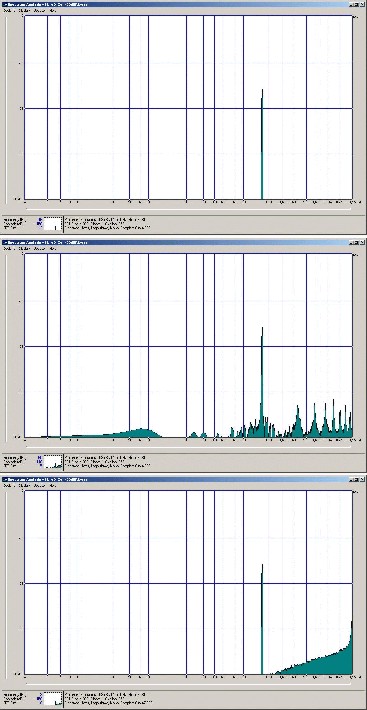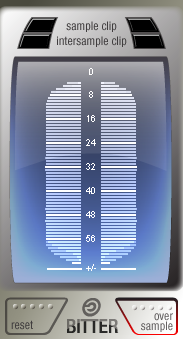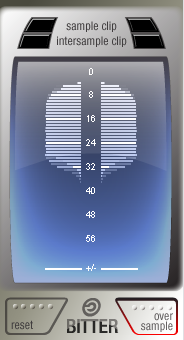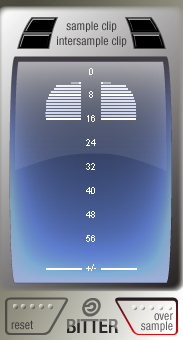I've found that when a recording is made in an actual acoustic environment, dithering isn't necessary because the natural noise floor serves as a dither. Does anyone else share that view?
I quit using dither when I found that the noise it adds is often audible. I use Waves L1, which does have fancier types of dither that are inaudible, but the user is cautioned to make sure that the program is never re-dithered or else there may be audible artifacts.
Of course, a recording made in an abstract setting such as digital reverb fading to silence absolutely must be dithered, but that's the exception in most of my recordings.
Topic Tags
Comments
The point you're missing is that truncating interacts with the e
The point you're missing is that truncating interacts with the existing low level noise to create unpleasant artifacts. What was random before now has a pattern as a result of the truncation. So you have to add a bit if noise to re-randomize that low level information and hide the artifacts.
OK, thanks for the explanation. Now I have lots of questions. Di
OK, thanks for the explanation. Now I have lots of questions. Dithering has always been a mystery to me.
1) What do people do to dither the track without adding audible noise?
2) If any artifacts do occur to due to truncating, will dithering it later smooth out the artifacts?
3) If some tracks in a compilation use higher-order dithering (which Waves says should never be redithered or else it may cause artifacts) and some don't, does the mastering engineer have to evaluate each track and possibly dither each one separately?
4) If a track is dithered and then faded in/out, does that fade now have to be dithered?
Obviously dithering has always been a mystery to me.
David Henderson, post: 373973 wrote: OK, thanks for the explanat
David Henderson, post: 373973 wrote: OK, thanks for the explanation. Now I have lots of questions. Dithering has always been a mystery to me.
1) What do people do to dither the track without adding audible noise?
2) If any artifacts do occur to due to truncating, will dithering it later smooth out the artifacts?
3) If some tracks in a compilation use higher-order dithering (which Waves says should never be redithered or else it may cause artifacts) and some don't, does the mastering engineer have to evaluate each track and possibly dither each one separately?
4) If a track is dithered and then faded in/out, does that fade now have to be dithered?Obviously dithering has always been a mystery to me.
1) Dithering adds noise at the very bottom, literally the lowest possible level that can be represented by 16 bit audio.
2) That's what it's for.
3) I don't know. There are some interesting issues there. For example, it might be good to go back to 24 bit files, but are they available with the mastering effects (eq, limiting etc.) or would you have to go back to unmastered mix files? I would lean toward remastering from the mix files if the end product was a compilation. I think redithering would generally not be good.
4) I suspect the fade algorithm would take care of it. What you don't want is a fade or decay that gets truncated without dithering.
David Henderson, post: 373918 wrote: I've found that when a reco
David Henderson, post: 373918 wrote: I've found that when a recording is made in an actual acoustic environment, dithering isn't necessary because the natural noise floor serves as a dither. Does anyone else share that view?
The "natural noise floor" of 24 bit audio is quantization distortion, which manifests down around -144dBFS in a hypothetically perfect system. However, typically, the quietest of digital systems will exhibit noise floors of around -120dB or so, because of their analog components (preamps, microphones, etc) and their inherent self-noise.
From Wikipedia:
"In 1981, researchers at Ampex determined that a dynamic range of 118 dB on a dithered digital audio stream was necessary for subjective noise-free playback of music in quiet listening environments."
What this ostensibly means is that we have plenty of dynamic range in undithered 24 bit audio to work without dithering until we get to the mastering phase, upon which time we apply dither to remedy the possible distortion gained by truncation of the signal down to 16 bits. In the real worlds, there are a few caveats, however.
FWIW, it is not uncommon for certain high end converter/PCI card combinations to apply dither as a matter of course to signals during recording and often along applying noise shaping. Of course, this can be turned on and off, as you would expect with high end gear.
David Henderson, post: 373918 wrote: I quit using dither when I found that the noise it adds is often audible. I use Waves L1, which does have fancier types of dither that are inaudible, but the user is cautioned to make sure that the program is never re-dithered or else there may be audible artifacts.
Applying 24-bit dither to 24-bit audio should not exhibit obvious noise and should only raise the relative noise floor around 3dB. The advantage gained from this is that signals traversing below the noise floor will attenuate smoothly and with linearity, without any truncation distortion. However, unless you're recording very dynamic music, like jazz or classical, this is probably not necessary.
16-bit audio, on the other hand, benefits from the effects of dither (and subsequentially noise shaping) quite immensely. This is because the 96dB of DR afforded to us can be quite insufficient to accurately represent some styles of really dynamic music, as described above. In that case, dither should be applied, to ensure signals attenuate smoothly below the noise floor. If the right noise shaping algorithm is applied, the resulting signal should sound more like 18 bits.
bouldersound wrote: Dithering is for covering up the artifacts of truncating from one word length ("bit depth") to a lower one. If you don't shorten the word length then you don't need to dither. Whether the low level signal in the mix is natural or artificial doesn't really matter.
While this is mostly true, I would say that if you are working in 16-bit, dither, along with noise shaping, can help you retain resolution immensely, especially with things like artificially generated reverb.
FYI, here's a little more info on dithering that I posted on another forum (because I don't feel like writing it all again):
Mo Facta wrote: The way I had dither demonstrated to me was with the Prism Sound DScope software by Prism Sound's Graham Boswell.
What he did was he created a 16-bit environment in DScope and turned the volume right up so that we could hear the absolute digital noise floor. This inherent noise is actually the sound of the lower bits in digital "silence" being truncated around -93dBfs (-96dBfs theoretical) - the lower limit of dynamic range in 16-bit. You can hear the same thing if you render a 16-bit file of digital silence and turn it up loud (provided the noise floor of your analog components do not exceed it).
He then introduced a VERY quiet 16-bit test tone of 1kHz to the noise (around -85dBfs or so) and attenuated it so that it's level diminished below the -93dBfs noise floor. Without dither the tone completely squarewaved at it crossed the noise threshold because, as I said above, the first quantization tier was not reached and the signal manifested as truncation distortion. This is the real effect of not dithering and why it is only the extremely low level stuff that gets affected, like reverb tails and cymbal decays. So, if you're producing really sparse music with many quiet passages I would say that dither might be more important to you.
After that, he introduced dither (the Prism Sound variety, of course) and we could clearly hear the increased noise floor, which now jumped to about -90dBfs. He once again introduced the quiet 1kHz tone and attenuated it until it reached the noise and low and behold, it diminished smoothly and with linearity below the noise into nothingness without any artifacts or distortion whatsoever. He then introduced noise shaping to the signal which pushed the excess noise to the upper register and virtually disposed of it. What we were left with was a clean, clear and smoothly diminishing 1kHz tone in an environment that actually EXCEEDED the noise limits of 16-bit audio. This is the reason why many dithering and noise shaping systems claim that you can achieve 16-bit audio that actually sounds more like 18-bits.
His conclusion was that with the proper dithering and noise shaping considerations, we have ALL the resolution we need in 16-bit audio. After it was demonstrated to me, I am inclined to agree with him.
However, just how all this affects a mix or music aesthetically is anyone's guess. That's up to you.
Cheers :)
Thanks, Mo. That's a lot of good infomation. The natural noise f
Thanks, Mo. That's a lot of good infomation. The natural noise floor is was referring to is ever-present ambient noise in an actual acoustic space. I record most live stereo concerts in 24-bit and mix them to CD, and I never hear artifacts from not using dither in that case. Crowd noise would cover up any artifacts, but I don't hear it if the room was empty, either (such as a recording session). I don't like extreme dynamics and tend to control the high and low extremes in the mix, so maybe the "low" level is way above the norm where one would expect to hear problems. I know what truncation grunge sounds like, but I seldom have a problem with it.
Ok, I see what you mean. But yeah, it would just mean that the
Ok, I see what you mean. But yeah, it would just mean that the intrinsic noise in your room is above the noise floor of your digital system. Most quiet rooms still exhibit 40dBSPL of noise. It would have to be a REALLY quiet room for you to hear quantization distortion on a decaying signal.
Cheers :)
David Henderson, post: 373982 wrote: ah-HA! That's what I was ge
David Henderson, post: 373982 wrote: ah-HA! That's what I was getting at. Most of the recording I do is in less-than-ideal environments, so I guess I've able to get away without using dither.
I think with most pop music the only places it really matters are the fade ins and outs.
Most of what I do is live concerts, and I'm always afraid of loc
Most of what I do is live concerts, and I'm always afraid of locking in a type of dither that will cause problems if any tracks are selected and re-dithered for an album. Is that a reasonable concern?
For commercial albums with a low ambient noise floor that are intended to be the final version, absolutely I agree that dithering is necessary. But what if the ambient noise is louder than the dither would be - why add more noise?
Boulder, that's a perfect solution for a perfect world. I live i
Boulder, that's a perfect solution for a perfect world. I live in the real world, where a client suddenly gets the idea to make a highlights CD of concerts recorded over the last 10 years, and not all, if any, recorded by me. If I gave clients 24-bit original recordings of concerts on DVD, they would likely immediately lose it (or toss it) after finding they can't play it in the car CD player; it doesn't matter how much I explain, they don't get it. I keep hard drive archives for some clients, but I can't be a warehouse for every concert I record. Better to leave concert one-offs undithered, and save dithering for albums.
And yes, I get it that you don't approve of me "mastering" my own recordings. This ain't Telarc, this is High School Band concerts.
David Henderson, post: 374479 wrote: I'm not on an ego trip, I j
David Henderson, post: 374479 wrote: I'm not on an ego trip, I just want to know:
What if the ambient noise is louder than the dither would be - why add more noise?
Because dither has to be added after truncation. It's the interaction of truncation with low level audio information that causes the distortion.
I can't believe that I'm so stupid that I can't understand this.
I can't believe that I'm so stupid that I can't understand this. 24-bit can capture a dynamic range down to the -127dB practical limit. 16-bit lops off everything below -96dB. There aren't any analog mics I know of with a higher S/N ratio than 80dB, and most concert halls have an ambient noise level of -60dB or so (from the loudest bass drum whack to an empty hall). After limiting peaks and managing levels, the truncation happens a full 50dB below the ambient noise floor. Why do I need dither?
Even waves that peak at 0dBFS have to cross zero. That's where t
Even waves that peak at 0dBFS have to cross zero. That's where the distortion happens. You just don't hear it because it's masked by the loud sound. But when the levels are lower they don't mask the distortion so well.
[Mods, the automatic wiki thing sucks. Why does a generic reference get changed into a link to a product I don't endorse? At least give me a cut of the profits.]
LOL at the auto-Wiki! I wondered why you were talking about Wave
LOL at the auto-Wiki! I wondered why you were talking about Waves LTD all of a sudden.
So you're saying that truncating ANY 24-bit file causes distortion where the waveform crosses the zero point? Does that mean that an undithered 16-bit bounce will sound different than the 24-bit mix? If I A/B the 24-bit mix and the undithered CD I should hear a difference, even if the whole track is -12dB or higher?
I don't think you'll hear anything resulting from truncating, di
I don't think you'll hear anything resulting from truncating, dithered or not, on higher level signal. It simply swamps your ear's ability to detect the distortion. But during fades or other places where the signal drops low enough the distortion can become audible.
Thanks, Boulder, I appreciate your wisdom and the pics. I suspec
Thanks, Boulder, I appreciate your wisdom and the pics. I suspect I've been operating in a narrow enough dynamic range that the distortion didn't matter. It seems that if a recording is going to wind up in a 16-bit format it's best to record it that way. Isn't the same principle true about resampling from 48kHz to 44.1kHz, and for the same reason? Resampling isn't going to plug any holes in the waveform made by the original format, it'll just make new holes.
Michael Fossenkemper, post: 374201 wrote: It's a bad habit to do
Michael Fossenkemper, post: 374201 wrote: It's a bad habit to do without at the final stage. Hopefully you won't always be working on less than ideal projects.
My idea of a "less than ideal" project is one that I don't get paid for. Limit one per customer - the last one.
David Henderson, post: 374496 wrote: Thanks, Boulder, I apprecia
David Henderson, post: 374496 wrote: Thanks, Boulder, I appreciate your wisdom and the pics. I suspect I've been operating in a narrow enough dynamic range that the distortion didn't matter. It seems that if a recording is going to wind up in a 16-bit format it's best to record it that way.
Nope. The benefits of recording in 24 bit far outweigh the miniscule loss of quality from dithering.
David Henderson, post: 374496 wrote: Isn't the same principle true about resampling from 48kHz to 44.1kHz, and for the same reason?
I don't think so, but opinions vary. I would rather have all the processing done at the higher sampling frequency and then drop it, relying on the good modern algorithms to keep the sound from degrading audibly. And If something I did ends up in a film, which uses 48kHz audio, I can go back to the 48kHz pre-master and avoid resampling altogether.
David Henderson, post: 374496 wrote: Resampling isn't going to plug any holes in the waveform made by the original format, it'll just make new holes.
I'm not sure what that means.
On the original topic of dither... Dither is a statistical proc
On the original topic of dither...
Dither is a statistical process using algorithms that are not dependent on the data. Different dithering algorithms give different results, but most produce results that are different from purely random noise, and very different from truncation.
What I have found is that dithering makes more of a difference to digitally-mixed sources than those mixed on an analog desk and digitized as a 2-track. I haven't researched this, but it could be, for example, that mixing many channels on a digital desk or in a DAW accentuates the quantization effects of the desk's internal mixing/truncation algorithms, similar to the sonic character build-up you get from laying down successive tracks all using the same microphone.
You should always dither at the last stage of going to a 16-bit CD file from a longer-wordlength mix. The only question to ask is which dithering algorithm is the best for this purpose given the nature of the source material and the process it has been through.
FWIW, thermal noise in 24-bit converters (well, their analog com
FWIW, thermal noise in 24-bit converters (well, their analog components, actually) act as a sort of "auto-dither" as dither itself is just randomized noise. This is why applying dither to 24 bit audio is mostly unnecessary. Sure, there will be signals down to the digital noise floor that will be truncated, but it is beyond any real-world dynamic range requirements and thus negligible.
And Dave Henderson, the gist of it is that you only really need dither when scaling bit depth down, say from 24 to 16 bit. This is really the only "rule". Many plugins employ dither as a matter of course to scale down after their 48 or 64 bit internal precision anyway so sometimes you're dealing with dither when you don't even know it. Some high end converters also employ dither as a matter of course (with various dither shapes as well as noise shaping). Of course, you can turn this off if you know what you're doing.
Forget about dither when you're mixing and keep working at the original bit depth. Dither will be necessary at the point that SNR becomes lower than the real world (120dB), as in 16 bit audio.
Cheers :)
I have another question. I'm doing a multi-track mix on compute
I have another question.
I'm doing a multi-track mix on computer with 24-bit files. The mix will end up on CD, but since I'm mixing a little of it at a time and bouncing in real time to a bused track the resulting mix will be 24-bit. If I dither the 24-bit mix to 16-bit as I bounce, can I then truncate the mix to 16-bit with no ill effects?
David Henderson, post: 374860 wrote: I have another question. I
David Henderson, post: 374860 wrote: I have another question.
I'm doing a multi-track mix on computer with 24-bit files. The mix will end up on CD, but since I'm mixing a little of it at a time and bouncing in real time to a bused track the resulting mix will be 24-bit. If I dither the 24-bit mix to 16-bit as I bounce, can I then truncate the mix to 16-bit with no ill effects?
Boulder has put you on the right track.
At the mix stage, keep all your operations at 24-bit with no dither, whether these are stems, buses or bounced mixes. Only when you have done the final 24-bit 2-track mix is the mix process finished and you move on to the next stage.
Are you mastering these tracks yourself for CD or sending them off to a mastering house? If you are sending them off, your part is done and you send the 24-bit raw mix. If you are burning to CD without the involvement of a mastering house, you would perform any pseudo-mastering operations on your 24-bit mix and only then truncate to 16-bit with dithering.
Remember to archive the 24-bit master mix as well as the 16-bit CD mix in case of a low-level problem on the CDs showing up needing a re-dither of the master mix using a different algorithm. This can happen!
David Henderson, post: 374860 wrote: If I dither the 24-bit mix
David Henderson, post: 374860 wrote: If I dither the 24-bit mix to 16-bit as I bounce, can I then truncate the mix to 16-bit with no ill effects?
Yes. You will end up with a 24 bit file with 16 bit dither, so you can now throw away the lowest 8 bits. Actually some dithering plugs will also truncate the audio for you, so the lowest 8 bits might already be all zeros by this stage. You could use a bit meter to verify this:
Schwa [[url=http://[/URL]="http://www.stillwel…"]Bitter[/]="http://www.stillwel…"]Bitter[/] showing Reaper's 64 bit mixing engine, with no other plugins:
With a 32 bit plug loaded (Ozone3) but doing nothing:
And with 16 bit dither enabled:








Dithering is for covering up the artifacts of truncating from on
Dithering is for covering up the artifacts of truncating from one word length ("bit depth") to a lower one. If you don't shorten the word length then you don't need to dither. Whether the low level signal in the mix is natural or artificial doesn't really matter.